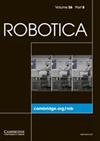利用进化算法合成典型柔性机构的计算机辅助设计工具
IF 2.7
4区 计算机科学
Q3 ROBOTICS
引用次数: 0
摘要
对于设计人员来说,准确预测机构的动态响应一直是一项具有挑战性的任务。出于建模简便性的考虑,机构的合成和优化大多局限于刚性系统,因此设计人员无法保证制造出的机构满足目标响应。为了解决这一局限性,本研究以柔性机构合成为目标。作为无数机械装置核心的两个基准机构是研究的范围,主要是柔性滑块-曲柄和四杆。除机构尺寸外,合成问题还包括材料属性。滑块曲柄机构有两个响应,即滑块速度和柔性连杆的中点轴向位移。而四杆机构的合成则有五个响应。对解决两种机构合成问题的七种优化技术进行了比较分析。随后,在 MATLAB® 下开发了用于机构合成的可执行计算机辅助设计工具。数值结果强调了基于单一响应的柔性机构合成的局限性。事实证明,将不同的响应结合起来可以减少可能出现的误差,并满足高精度要求。本文章由计算机程序翻译,如有差异,请以英文原文为准。
Computer-aided design tool for typical flexible mechanisms synthesis by means of evolutionary algorithms
Accurate prediction for mechanisms’ dynamic responses has always been a challenging task for designers. For modeling easiness purposes, mechanisms’ synthesis and optimization have been mostly limited to rigid systems, making consequently the designer unable to vow that the manufactured mechanism satisfies the target responses. To address this limitation, flexible mechanism synthesis is aimed in this work. Two benchmark mechanisms being the core of myriad mechanical devices are of scope, mainly, the flexible slider-crank and the four-bar. In addition to the mechanism dimensions, materials properties have been embedded in the synthesis problem. Two responses are of interest for the slider-crank mechanism, the slider velocity, and the midpoint axial displacement for the flexible connecting rod. Whereas five responses have been compiled for the four-bar mechanism synthesis. A comparative analysis of seven optimization techniques to solve the synthesis problem for both mechanisms has been performed. Subsequently, an executable computer-aided design tool for mechanisms synthesis has been developed under MATLAB®. Numerical outcomes emphasize the limits of a single-response-based synthesis for a flexible mechanism. It has been proven that combining different responses alleviates possible error and fulfill high-accuracy requirement.
求助全文
通过发布文献求助,成功后即可免费获取论文全文。
去求助
来源期刊

Robotica
工程技术-机器人学
CiteScore
4.50
自引率
22.20%
发文量
181
审稿时长
9.9 months
期刊介绍:
Robotica is a forum for the multidisciplinary subject of robotics and encourages developments, applications and research in this important field of automation and robotics with regard to industry, health, education and economic and social aspects of relevance. Coverage includes activities in hostile environments, applications in the service and manufacturing industries, biological robotics, dynamics and kinematics involved in robot design and uses, on-line robots, robot task planning, rehabilitation robotics, sensory perception, software in the widest sense, particularly in respect of programming languages and links with CAD/CAM systems, telerobotics and various other areas. In addition, interest is focused on various Artificial Intelligence topics of theoretical and practical interest.
 求助内容:
求助内容: 应助结果提醒方式:
应助结果提醒方式:


